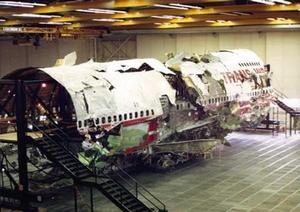AviationFormer investigators pushing for new look into TWA flight 800 crash
Former investigators want to reopen the case of the 1996 TWA Flight 800 crash off the coast of Long Island. They say that new evidence points to a missile strike that may have hit the jet. Theories of an errant missile being fired from a U.S. military vessel – advanced, among others, by Pierre Salinger, who was JFK’s press secretary in the early 1960s — were refuted, but a separate theory of shoulder-fired missile fired by terrorists has lingered.

Reconstruction of the downed TWA flight 800 // Source: commons.wikimedia.org
Former investigators want to reopen the case of the 1996 TWA Flight 800 crash off the coast of Long Island. They say that new evidence points to a missile strike that may have hit the jet.
The flight, which was heading to Paris, crashed just minutes after taking off from John F. Kennedy Airport in Queens, New York.
WFTV reports that one reason for the effort to reopen the case is a documentary on the crash which features testimony from former investigators. These investigators question the National Transportation Safety Board’s (NTSB) conclusion that the cause of the crash was a fuel tank explosion caused by a short circuit in the wiring.
“We don’t know who fired the missile,” Jim Speer, an accident investigator for the Air Line Pilots Association, told WFTV. “But we have a lot more confidence that it was a missile.”
The NTSB issued a statement on Wednesday saying it is aware of the documentary.
“All petitions for reconsideration are thoroughly reviewed, and a determination is usually made within about 60 days,” NTSB spokeswoman Kelly Nantel told WFTV. “While the NTSB rarely re-investigates issues that have already been examined, our investigations are never closed and we can review any new information not previously considered by the board.”
Nantel went on to note that the TWA Flight 800 investigation lasted four years.
“Investigators took great care reviewing, documenting and analyzing facts and data and held a five-day hearing to gather additional facts before determining the probable cause of the accident during a two-day board meeting.”
A petition to reopen the case was filed on Wednesday by former NTSB accident investigator Hank Hughes, and Bob Young, former senior accident investigator for the now-defunct TWA. The pair say they have “reviewed the FAA radar evidence along with new evidence not available to the NTSB during the official investigation and contend that the NTSB’s probable cause determination is erroneous and should be reconsidered and modified accordingly.”
The petition went on to say that “new analyses of the FAA radar evidence demonstrate that the explosion that caused the crash did not result from a low-velocity fuel-air explosion as the NTSB has determined. Rather, it was caused by a detonation or high-velocity explosion.”
Speculation of a missile strike began almost immediately after the plane was destroyed. Theories of an errant missile being fired from a U.S. military vessel – advanced, among others, by Pierre Salinger, who was JFK’s press secretary in the early 1960s — were refuted, but a separate theory of should-fired missile fired by terrorists has lingered.
According to John Seaman, leader of an organization of TWA 800 victims’ families, the case should not be reopened unless there is compelling evidence that the NTSB’s conclusion is false.
“Unless something was to develop that would be very clear and compelling, then a lot of these interested parties are not really helpful,” Seaman, whose niece died on the flight told WFTV. “They reopen wounds,” he said of the petitioners. “Personally I can’t keep going over it again and again. I think most families feel that way.”
